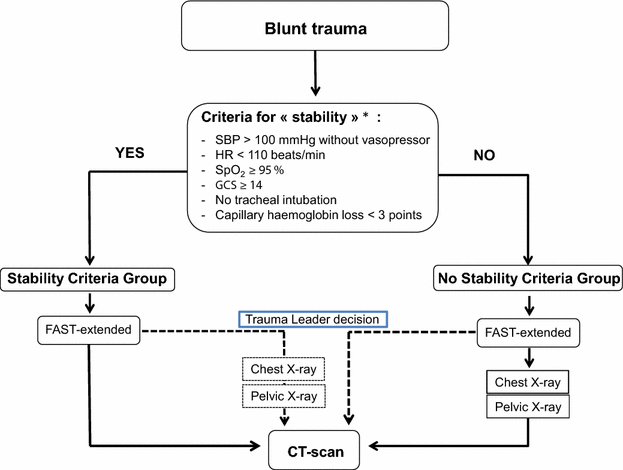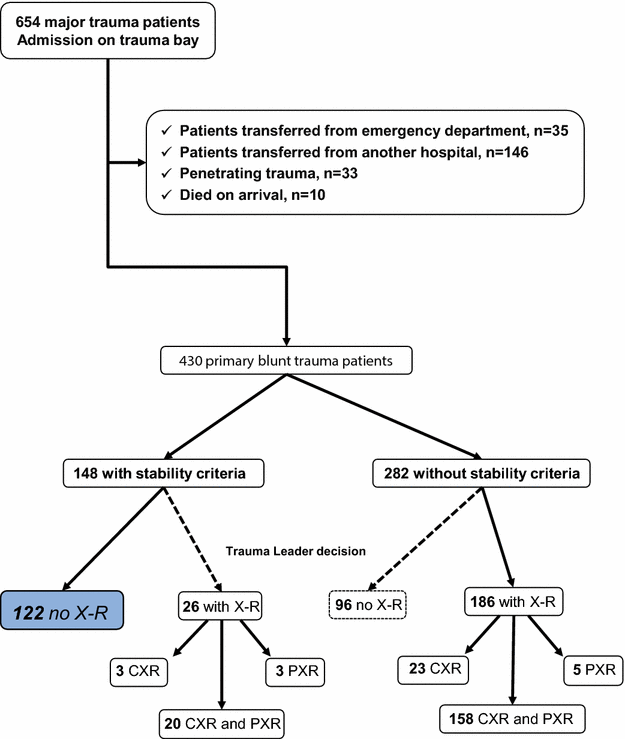Integrating eFAST in the initial management of stable trauma patients: the end of plain film radiography
- PMID: 27401440
- PMCID: PMC4940356
- DOI: 10.1186/s13613-016-0166-0
Integrating eFAST in the initial management of stable trauma patients: the end of plain film radiography
Abstract
Background: The initial management of a trauma patient is a critical and demanding period. The use of extended focused assessment sonography for trauma (eFAST) has become more prevalent in trauma rooms, raising questions about the real "added value" of chest X-rays (CXRs) and pelvic X-rays (PXR), particularly in haemodynamically stable trauma patients. The aim of this study was to evaluate the effectiveness of a management protocol integrating eFAST and excluding X-rays in stable trauma patients.
Methods: This was a prospective, interventional, single-centre study including all primary blunt trauma patients admitted to the trauma bay with a suspicion of severe trauma. All patients underwent physical examination and eFAST (assessing abdomen, pelvis, pericardium and pleura) before a whole-body CT scan (WBCT). Patients fulfilling all stability criteria at any time in transit from the scene of the accident to the hospital were managed in the trauma bay without chest and PXR.
Results: Amongst 430 patients, 148 fulfilled the stability criteria (stability criteria group) of which 122 (82 %) had no X-rays in the trauma bay. No diagnostic failure with an immediate clinical impact was identified in the stability criteria group (SC group). All cases of pneumothorax requiring chest drainage were identified by eFAST associated with a clinical examination before the WBCT scan in the SC group. The time spent in the trauma bay was significantly shorter for the SC group without X-rays compared to those who received any X-ray (25 [20; 35] vs. 38 [30; 60] min, respectively; p < 0.0001). An analysis of the cost and radiation exposure showed savings of 7000 Є and 100 mSv, respectively.
Conclusions: No unrecognized diagnostic with a clinical impact due to the lack of CXR and PXR during the initial management of stable trauma patients was observed. The eFAST associated with physical examination provided the information necessary to safely complete the WBCT scan. It allowed a sensible cost and radiation saving.
Keywords: Diagnostic accuracy; Imaging; Resuscitation; Severe trauma; Stability; Ultrasound.
Figures


Similar articles
-
Integrating extended focused assessment with sonography for trauma (eFAST) in the initial assessment of severe trauma: Impact on the management of 756 patients.Injury. 2018 Oct;49(10):1774-1780. doi: 10.1016/j.injury.2018.07.002. Epub 2018 Jul 8. Injury. 2018. PMID: 30017184
-
The combined utility of extended focused assessment with sonography for trauma and chest x-ray in blunt thoracic trauma.J Trauma Acute Care Surg. 2018 Jul;85(1):113-117. doi: 10.1097/TA.0000000000001868. J Trauma Acute Care Surg. 2018. PMID: 29958248
-
Hand-held thoracic sonography for detecting post-traumatic pneumothoraces: the Extended Focused Assessment with Sonography for Trauma (EFAST).J Trauma. 2004 Aug;57(2):288-95. doi: 10.1097/01.ta.0000133565.88871.e4. J Trauma. 2004. PMID: 15345974
-
Extended Focused Assessment with Sonography for Trauma in the Emergency Department: A Comprehensive Review.J Clin Med. 2025 May 15;14(10):3457. doi: 10.3390/jcm14103457. J Clin Med. 2025. PMID: 40429451 Free PMC article. Review.
-
Whole body computed tomography in multi trauma patients: Review of the current literature.Turk J Emerg Med. 2018 Oct 3;18(4):142-147. doi: 10.1016/j.tjem.2018.09.003. eCollection 2018 Dec. Turk J Emerg Med. 2018. PMID: 30533556 Free PMC article. Review.
Cited by
-
eFAST for the diagnosis of a perioperative complication during percutaneous nephrolithotomy.Crit Ultrasound J. 2018 Apr 3;10(1):7. doi: 10.1186/s13089-018-0088-1. Crit Ultrasound J. 2018. PMID: 29616352 Free PMC article.
-
Diagnostic value of chest radiography in the early management of severely injured patients with mediastinal vascular injury.Eur J Trauma Emerg Surg. 2022 Oct;48(5):4223-4231. doi: 10.1007/s00068-022-01966-3. Epub 2022 Apr 7. Eur J Trauma Emerg Surg. 2022. PMID: 35389063 Free PMC article.
-
Speckle tracking quantification of lung sliding for the diagnosis of pneumothorax: a multicentric observational study.Intensive Care Med. 2019 Sep;45(9):1212-1218. doi: 10.1007/s00134-019-05710-1. Epub 2019 Jul 29. Intensive Care Med. 2019. PMID: 31359081
-
Point-of-care Ultrasonography for Detecting the Etiology of Unexplained Acute Respiratory and Chest Complaints in the Emergency Department: A Prospective Analysis.Cureus. 2018 Aug 28;10(8):e3218. doi: 10.7759/cureus.3218. Cureus. 2018. PMID: 30405993 Free PMC article.
-
A possible role of e-FAST in the hemodynamically stable polytrauma patient: results of a single trauma center preliminary restrospective study.J Ultrasound. 2025 Mar;28(1):75-79. doi: 10.1007/s40477-024-00962-0. Epub 2024 Nov 9. J Ultrasound. 2025. PMID: 39521752
References
LinkOut - more resources
Full Text Sources
Other Literature Sources

